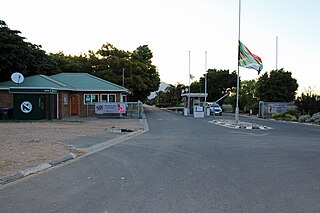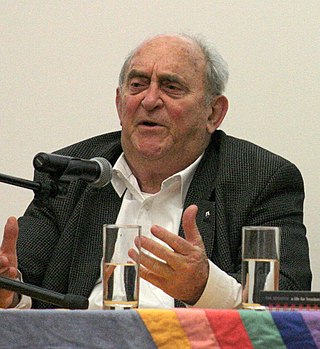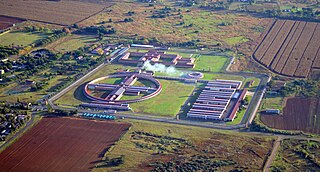
Winnie Madikizela-Mandela, also known as Winnie Mandela, was a South African anti-apartheid activist, convicted kidnapper, politician, and the second wife of Nelson Mandela. She served as a Member of Parliament from 1994 to 2003, and from 2009 until her death, and was a deputy minister of arts and culture from 1994 to 1996. A member of the African National Congress (ANC) political party, she served on the ANC's National Executive Committee and headed its Women's League. Madikizela-Mandela was known to her supporters as the "Mother of the Nation".

Walter Max Ulyate Sisulu was a South African anti-apartheid activist and member of the African National Congress (ANC). Between terms as ANC Secretary-General (1949–1954) and ANC Deputy President (1991–1994), he was Accused No.2 in the Rivonia Trial and was incarcerated on Robben Island where he served more than 25 years' imprisonment for his anti-Apartheid revolutionary activism. He had a close partnership with Oliver Tambo and Nelson Mandela, with whom he played a key role in organising the 1952 Defiance Campaign and the establishment of the ANC Youth League and Umkhonto we Sizwe. He was also on the Central Committee of the South African Communist Party.
Raymond Mphakamisi Mhlaba OMSG was an anti-apartheid activist, Communist and leader of the African National Congress (ANC) also as well the first premier of the Eastern Cape. Mhlaba spent 25 years of his life in prison. Well known for being sentenced, along with Nelson Mandela, Govan Mbeki, Walter Sisulu and others in the Rivonia Trial, he was an active member of the ANC and the South African Communist Party (SACP) all his adult life. His kindly manner brought him the nickname "Oom Ray".

Ahmed Mohamed Kathrada OMSG, sometimes known by the nickname "Kathy", was a South African politician and anti-apartheid activist.

The Constitution Hill precinct is the seat of the Constitutional Court of South Africa. It is located in Braamfontein, Johannesburg near the western end of the suburb of Hillbrow. The complex consists of the Constitutional Court, the Old Fort Prison and museum.

Drakenstein Correctional Centre is a low-security prison between Paarl and Franschhoek, on the R301 road 5 km from the R45 Huguenot Road, in the valley of the Dwars River in the Western Cape of South Africa. The prison is the location where Nelson Mandela spent the last part of his imprisonment for campaigning against apartheid.

Denis Theodore Goldberg was a South African social campaigner who was active in the struggle against apartheid. He was accused No. 3 in the Rivonia Trial, alongside the better-known Nelson Mandela and Walter Sisulu, where he was also the youngest of the defendants. He was imprisoned for 22 years, along with other key members of the anti-apartheid movement in South Africa. After his release in 1985 he continued to campaign against apartheid from his base in London with his family, until the apartheid system was fully abolished with the 1994 election. He returned to South Africa in 2002 and founded the non-profit Denis Goldberg Legacy Foundation Trust in 2015. He was diagnosed with lung cancer in July 2017, and died in Cape Town on 29 April 2020.
The Department of Correctional Services is a department of the South African government. It is responsible for running South Africa's prison system. The department has about 34,000 staff and is responsible for the administration of 240 prisons, which accommodates about 189,748 inmates. The prisons include minimum, medium and maximum security facilities. The agency is headquartered in the West Block of the Poyntons Building in Pretoria.
Tony Sithembiso Yengeni is a South African politician and former anti-apartheid activist. He represented the African National Congress (ANC) in the National Assembly from May 1994 to March 2003, including as Chief Whip of the Majority Party from November 1998 to October 2001. He was a member of the ANC National Executive Committee between 1994 and 2022, though he resigned from legislative politics after he was convicted of fraud in 2003.

Prisons in South Africa are run by the Department of Correctional Services. The department is divided into six administrative regions, each with its own regional commissioner, and subdivided into multiple areas, each headed by an area commissioner. According to the ministry, there are approximately 34,000 employees of the department running 240 prisons. In those prisons are nearly 156,000 inmates as of August 2013. The prisons include minimum, medium, maximum and super-maximum security facilities. They may be entirely dedicated to a specific group of prisoners, such as women or children, or be divided into separate sections for each group. Since 2019, the Minister of Correctional Services has been Ronald Lamola.

Nelson Rolihlahla Mandela was a South African anti-apartheid activist, politician, and statesman who served as the first president of South Africa from 1994 to 1999. He was the country's first black head of state and the first elected in a fully representative democratic election. His government focused on dismantling the legacy of apartheid by fostering racial reconciliation. Ideologically an African nationalist and socialist, he served as the president of the African National Congress (ANC) party from 1991 to 1997.
The Numbers Gang is a South African crime organization that originated as an African nationalist organisation. It is believed that they are present in most South African prisons. The gang was founded in KwaZulu-Natal The gang is divided into groups — the 26s, 27s and 28s.

Timothy Peter Jenkin is a South African writer, anti-apartheid activist and former political prisoner. He is best known for his 1979 escape from Pretoria Local Prison, along with Stephen Lee and Alex Moumbaris.
Pretoria Central Prison, renamed Kgosi Mampuru II Management Area by former President Jacob Zuma on 13 April 2013 and sometimes referred to as Kgosi Mampuru II Correctional Services is a large prison in central Pretoria, within the City of Tshwane in South Africa. It is operated by the South African Department of Correctional Services.
Mikhael Subotzky is a South African artist based in Johannesburg. His installation, film, video and photographic work have been exhibited widely in museums and galleries, and received awards including the KLM Paul Huf Award, W. Eugene Smith Grant, Oskar Barnack Award and the Discovery Award at Rencontres d'Arles. He has published the books Beaufort West (2008), Retinal Shift (2012) and, with Patrick Waterhouse, Ponte City (2014). Subotzky is a member of Magnum Photos.

Sonia Bunting, OLS was a South African journalist, and a political and anti-apartheid activist. After being charged with treason and imprisoned, being detained a second time, and barred from publishing, she and her husband went into exile in London, where she joined the Anti-Apartheid Movement (AAM) and organised the World Campaign for the Release of South African Political Prisoners. When the African National Congress (ANC) ban was lifted in 1991, she returned to South Africa where she was involved in political activism until her death in 2001. She was posthumously honored by the government of South Africa with the Order of Luthuli in Silver in 2010.

Robben Island Prison is an inactive prison on Robben Island in Table Bay, 6.9 kilometers (4.3 mi) west of the coast of Bloubergstrand, Cape Town, South Africa. Nobel Laureate and former President of South Africa Nelson Mandela was imprisoned there for 18 of the 27 years he served behind bars before the fall of apartheid. Since then, three former inmates of the prison have gone on to become President of South Africa.
Stephen Bernard Lee is a South African former political prisoner best known for his 1979 escape from Pretoria Local Prison with friend and fellow activist Tim Jenkin and a third inmate, Alex Moumbaris.

Devikarani Priscilla Sewpal Jana was a South African human rights lawyer, politician and diplomat. As a member of the African National Congress (ANC) during the anti-apartheid movement, she participated in both legal activism as well as in the underground movement to end apartheid. She represented many significant figures in the movement, including South African president Nelson Mandela, Winnie Madikizela-Mandela, Steve Biko, Govan Mbeki, Walter Sisulu, and Archbishop Desmond Tutu. Jana was one of the very few South Africans who had access to political prisoners, including Mandela, in the maximum security Robben Island prison, and served as an emissary for coded messages between the political prisoners and the ANC leadership.

Ebrahim Ismail Ebrahim OLG was a South African anti-apartheid activist of Indian origin who was a member of the African National Congress's armed wing uMkhonto we Sizwe. He was tried in the Pietermaritzburg sabotage trials of 1963 and was sentenced to a 15-year imprisonment at the Robben Island Maximum Security Prison.














